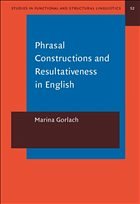Nicht lieferbar

Phrasal Constructions and Resultativeness in English
A sign-oriented analysis
Versandkostenfrei!
Nicht lieferbar
Main description:Eat up the apple orEat the apple up? Is there any difference in the messages each of these alternative forms sends? If there isn’t, why bother to keep both? On the other hand, is there any semantic similarity between eat the apple up and break the glass to pieces? This study takes a fresh look at a still controversial issue of phrasal verbs and their alternate word order applying sign-oriented theory and methodology. Unlike other analyses, it asserts that there is a semantic distinction between the two word order variants phrasal verbs may appear in. In order to test this di...
Main description:
Eat up the apple or
Eat the apple up
? Is there any difference in the messages each of these alternative forms sends? If there isn’t, why bother to keep both? On the other hand, is there any semantic similarity between eat the apple up and break the glass to pieces? This study takes a fresh look at a still controversial issue of phrasal verbs and their alternate word order applying sign-oriented theory and methodology. Unlike other analyses, it asserts that there is a semantic distinction between the two word order variants phrasal verbs may appear in. In order to test this distinction, the author analyzes a large corpus of data and also uses translation into a language having a clear morphological distinction between resultative/non-resultative forms (Russian). As follows from the analysis, English has morphological and syntactic tools to express resultative meaning, which allows suggesting a new lexico-grammatical category - resultativeness.
Table of contents:
- List of tables
- List of figures
- Abstract
- Introduction
- 1. The sign-oriented approach
- 2. Phrasal constructions and resultative meaning
- 3. Resultativeness
- 4. Microlevel analysis
- 5. Macrolevel Analysis
- Conclusion
- Notes
- References
- Index
Eat up the apple or
Eat the apple up
? Is there any difference in the messages each of these alternative forms sends? If there isn’t, why bother to keep both? On the other hand, is there any semantic similarity between eat the apple up and break the glass to pieces? This study takes a fresh look at a still controversial issue of phrasal verbs and their alternate word order applying sign-oriented theory and methodology. Unlike other analyses, it asserts that there is a semantic distinction between the two word order variants phrasal verbs may appear in. In order to test this distinction, the author analyzes a large corpus of data and also uses translation into a language having a clear morphological distinction between resultative/non-resultative forms (Russian). As follows from the analysis, English has morphological and syntactic tools to express resultative meaning, which allows suggesting a new lexico-grammatical category - resultativeness.
Table of contents:
- List of tables
- List of figures
- Abstract
- Introduction
- 1. The sign-oriented approach
- 2. Phrasal constructions and resultative meaning
- 3. Resultativeness
- 4. Microlevel analysis
- 5. Macrolevel Analysis
- Conclusion
- Notes
- References
- Index




